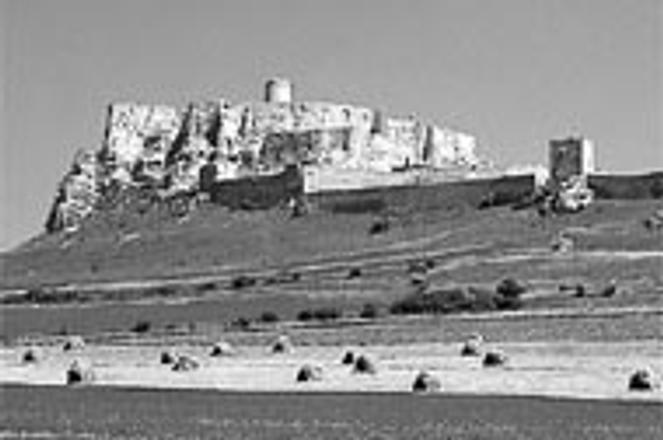White mound. Spiš Castle is one sight that looks much smaller from afar than when viewed from close range.Richard Lewis
The bus huffs its way up one of the hundreds of hills that, like ripples of water; define the rolling landscape of the Spiš region. Outside the left window, a hanglider takes off from the crown of a hill colored deep brown by potato patches and swoops down ino the wide bowl of a valley that holds a string of villages unspoiled by time. Beyond the bus's back window, the High Tatras tower like grand- parents presiding over their brood of hills. Through the windshield and across the valley lies the gate to Slovak Paradise (Slovenský raj) and the dense, dark beauty sheltered by its canopy of trees.
Every mile carries with it the crest of another hill and the enchanting panorama of another piece of the Spiš region. In this simple land, Slovakia's bosom, sweet treasures abound. Jewels like Spišská Kapitula, a walled-in church and seminary that still houses God's students to this day, and the 13th century wooden church at Žehra, whose humble onion dome contrasts sharply with the Gothic churches in the towns around it.
These places of simple beauty did not appear by happenstance; they harken back to the 15th and 16th centuries, when the Spiš region was the crossroads of an energetic trade route that brought merchants from the Black and Baltic Seas west to Vienna and home again. During this time, 13 towns under the umbrella of the German Zips - from which Spiš derives its name - flourished in a sea of Hungarian rule. Granted the right to collect taxes from traders, these towns enjoyed an almost two-century run of prosperity, the bounty of which endures to this day.
Stunning
The most stunning prize in Spiš is its castle, now the largest ruin in central Europe. Viewed from afar, Spiš Castle doesn't look all that impressive. Sure, it's big, a chalky white mound that rises from the valley on a verdant hill, but then the only comparison is the silhouette of the hills behind, which provide an almost unreal backdrop to the castle and the wide valley around it.
From the bottom of the hill the ruin sits on, though, Spiš Castle fills the eyes as if it were the focal point of a telescope aimed at the Moon. Stems of steel stick out of the huge, cavernous structure of white, suggesting restoration work but, considering the inactivity, more likely propping up the tired stones. The hill, so friendly and inviting from afar, looks different up close.
The dark dirt trail marking the ascent is tipped at an uninviting angle; off the path, wild grass four feet high runs thick, tipped by little buds of purple, yellow and pink flowers.
Spiš Castle was destroyed in 1780, when a fire feasted on the rich wooden planks that had given the interior its finesse. Built in 1209 on an even earlier Slavic fortress, the structure stood for four centuries as the administrative center of the Spis region. Later it was passed from one Hungarian noble to another, who used it as a bastion of power on the kingdom's northernmost outpost. The castle's last owner, the Csáky family, moved out after the 1780 fire, and central Europe's second largest structure began its descent into disrepair.
Now, white pillars engulf what may have been a room; wind whips through the huge holes that were once windows in busy crosscurrents, meeting with blasts from adjoining spaces. Through one portal, a sloping field of green is interrupted by a curling line of stones that demarcate a curiously simple religious site.
Beyond the green pitch dotted with stones, the valley unfolds like a carpet just shaken and placed on the floor, still waiting for the wrinkles to be straightened out. Peace reigns supreme, making it hard to imagine that this castle was a frequent target of violent battles between ancient tribes as they indiscriminately criss-crossed Europe's ancient lands.
S&S Travel tips
How to get there
The bus runs from Spišská Nová Ves to the center of Spišské Podhradie, a 10-minute walk to the base of the castle. Rail connection is a local, single-car train that takes you from Spišské Vlachy to the base of the castle in a pleasant 20-minute ride.
Important place
Spišský Hrad- Spišské Podhradie, 0966/8336. Open Tue-Sun 9-17. Last admittance at 16:30.
S&S Travel Tips for Levoča
Informáčne Centrum- Cultural and information center, tel.: 0966/ 510-416.
GETTING THERE
By Car- From Bratislava follow the four-lane highway E75 north all the way to Žilina (198 km). The high speeds of the highway give way to slow town traffic about 27 km before Trenčín. From Žilina it is another 169 km to Levoča on E50, which follows the Váh River. Total trip time takes about five hours.
By Bus- One bus a day goes directly from Bratislava (takes about 8 hours). Best to get there from Poprad or Košice. There is also a 20 minute commuter train from Spišská Nová Ves.
LODGING
Hotel Barbakan- Košická 15, 054 01 Levoča, tel.: 0966/ 513-608, fax: 0966/ 513-609. Prices (including breakfast) for a double room are 690 Sk for Slovaks, 1,190 Sk for foreigners.
Hotel Satel- Nám. Majstra Pavla 55, 054 01 Levoča, tel.: 0966/ 512-943, fax: 0966/ 514-486. Prices for a double room are 900 Sk for Slovaks, 1,800 Sk for foreigners. Add 50 Sk for breakfast. Helpful staff.
Hotel Arkadia- Nám. Majstra Pavla 26, 054 01 Levoča, tel./fax: 0966/ 612-255. Prices for a double room are 660 Sk for Slovaks, 1,150 Sk for foreigners. Add 60 Sk for breakfast.
RESTAURANTS
Reštaurácia U 3 Apostolov- Nám. Majstra Pavla 11, 054 01 Levoča, tel./fax: 0966/ 512-302. Slovak specialties as well as a wide selection of vegetarian dishes. Prices are a bit pricey but the food is excellent.


